Introduction to when to plant red onions
Red onions, with their vibrant color and distinct flavor, have gained popularity in kitchens around the world. Knowing the optimal time to plant red onions is crucial for a successful harvest. In this comprehensive guide, we will explore the factors that influence planting time, provide detailed instructions for both spring and fall planting, offer tips for caring for red onions, and troubleshoot common problems.
Whether you’re a seasoned gardener or a beginner, this article will equip you with the knowledge to grow flourishing red onion crops. For further resources and expert guidance, visit plantcoachcenter.com.
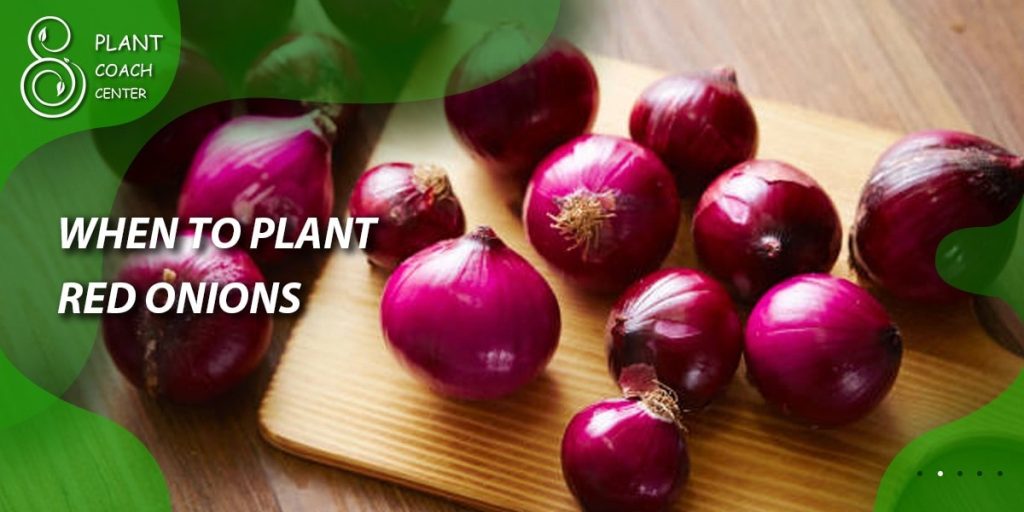
Understanding Red Onions
Red onions, scientifically known as Allium cepa, belong to the Allium family and are a variety of onion known for their deep purple or red skin and a milder, sweeter flavor compared to yellow or white onions. These versatile vegetables not only add flavor to various dishes but also provide several nutritional benefits. Red onions are rich in antioxidants, vitamins, and minerals, making them a valuable addition to a healthy diet.
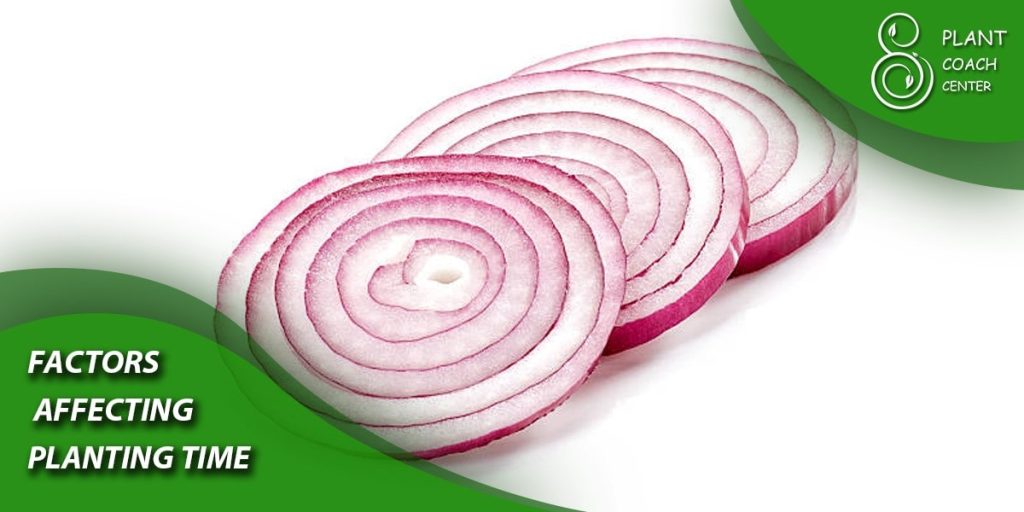
Factors Affecting Planting Time
When deciding when to plant red onions, several factors come into play. Understanding these factors is essential for successful onion cultivation.
Climatic Considerations
The climate in your growing region significantly impacts the timing of red onion planting. Consider the following:
– Optimal Temperature Range for Red Onions: Red onions thrive in temperatures between 55°F (13°C) and 75°F (24°C). Cooler temperatures promote bulb development, while excessive heat can hinder growth.
– Frost Tolerance and Sensitivity: Red onions are relatively cold-tolerant but can be damaged by severe frosts. It is crucial to consider the frost dates in your region when planning your planting time.
Daylight Duration and Photoperiod Requirements
Onions, including red onions, are sensitive to daylight duration. The number of daylight hours influences bulb formation. Understanding the photoperiod requirements of red onions can help you determine the appropriate planting time.
Soil Conditions and Preparation
Red onions have specific soil requirements for optimal growth. Consider the following soil conditions:
– Soil Type Preferences: Red onions prefer well-draining soil with a loamy texture. Sandy or loamy soil types are ideal, as they provide good aeration and drainage.
– Soil pH and Fertility Requirements: Red onions thrive in slightly acidic to neutral soil, with a pH range between 6.0 and 7.0. Conduct a soil test to determine the pH level and make necessary amendments. Additionally, enrich the soil with organic matter to enhance fertility and moisture retention.
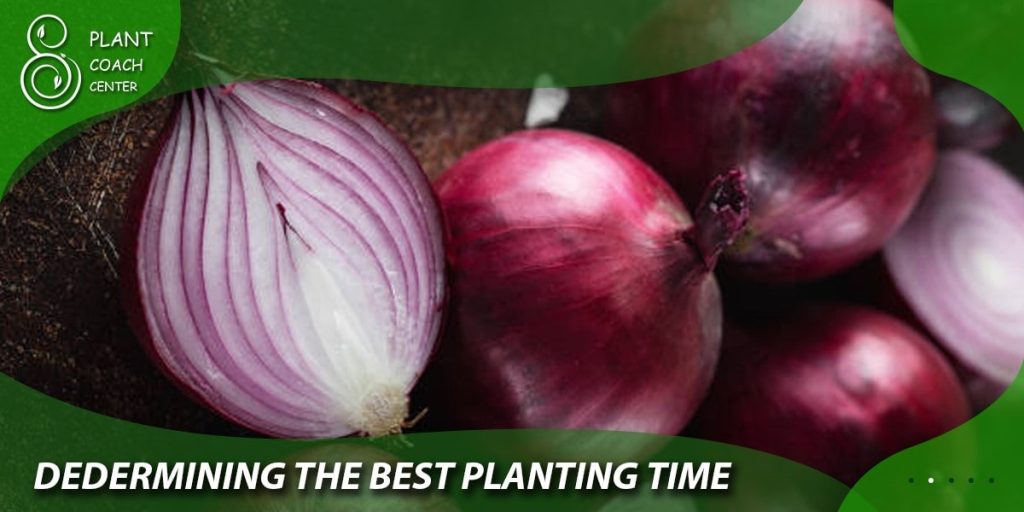
Determining the Best Planting Time
To determine the best time to plant red onions, take into account the specific conditions of your growing region and the growth cycle of red onions.
Growing Regions and Their Climates
Different regions have varying climates and growing seasons, which affect the planting time for red onions. Research your local climate and identify your USDA hardiness zone to determine the optimal planting window.
Local Climate Data and Frost Dates
Consult local climate data and the average last frost date in your area. This information will help you determine when it is safe to plant red onions without the risk of frost damage.
Understanding the Onion Growth Cycle
Understanding the growth cycle of red onions is crucial for successful timing. Red onions go through several stages from planting to maturity.
– Onion Growth Stages: The growth stages include seed germination, vegetative growth, bulb formation, and maturation. Knowing the approximate durations of these stages for your selected red onion variety will help you plan the planting time accordingly.
– Days to Maturity for Different Red Onion Varieties: Red onion varieties have varying maturity periods. Check the seed packet or catalog information to estimate the number of days it takes for a particular variety to reach maturity.
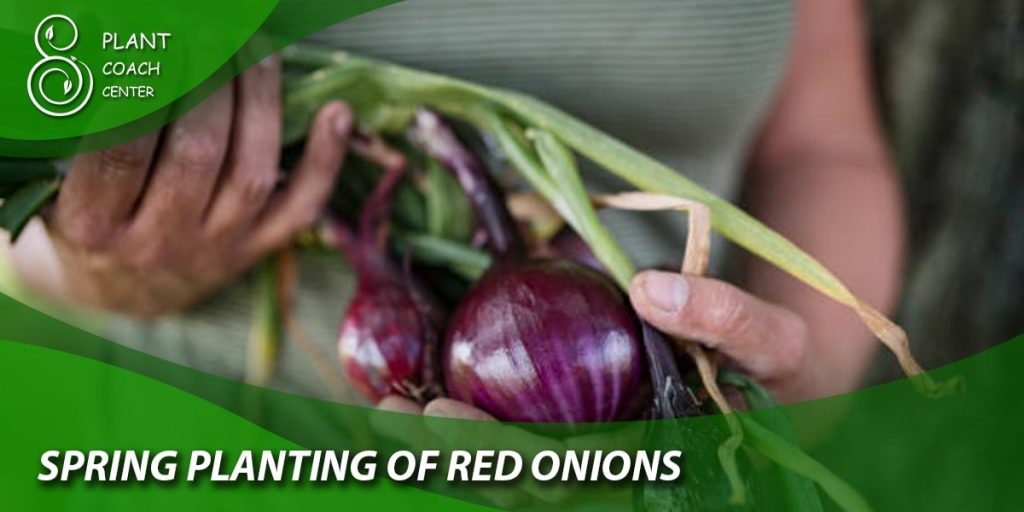
Spring Planting of Red Onions
Spring is a popular time for planting red onions, offering favorable conditions for their growth. Follow these steps for successful spring planting:
Preparing for Spring Planting
Before planting red onions in spring, prepare the garden bed to create a suitable environment for their growth:
– Clear the Bed: Remove any weeds, rocks, or debris from the planting area.
– Amend the Soil: Conduct a soil test to assess its fertility and pH level. Amend the soil as needed, adding compost or well-rotted manure to improve its structure and nutrient content.
– Choose Healthy Onion Sets or Seedlings: Select high-quality onion sets or seedlings from a reputable source.
Ideal Soil Temperature and Conditions
Red onions require specific soil temperatures and conditions for successful growth:
– Soil Temperature: The soil temperature should be around 50°F (10°C) or higher for optimal red onion seed germination.
– Moisture and Drainage: Ensure the soil is adequately moist but well-draining to prevent waterlogging, which can lead to rotting.
Steps for Direct Sowing Red Onion Seeds
Direct sowing red onion seeds is a cost-effective method for startingred onions. Here’s a step-by-step guide:
Prepare the Soil: Loosen the soil to a depth of 6-8 inches (15-20 cm) using a garden fork or tiller. Remove any weeds or debris and create a fine, crumbly seedbed.
Sow the Seeds: Create furrows in the soil, about 1/2 inch (3 cm) deep and 12-18 inches (30-45 cm) apart. Sow the red onion seeds thinly along the furrows, maintaining a spacing of about 1 inch (2.5 cm) between seeds. Cover the seeds with soil and gently firm the surface.
Water the Seeds: After sowing, water the bed thoroughly to ensure good seed-to-soil contact. Be careful not to wash away the seeds. Maintain consistent soil moisture throughout the germination period.
Thin the Seedlings: Once the seedlings emerge and reach a height of 2-3 inches (5-7.5 cm), thin them out to provide adequate space for growth. Remove the weaker seedlings, leaving a spacing of 4-6 inches (10-15 cm) between the remaining plants.
Provide Care and Maintenance: Continue to water the seedlings regularly, keeping the soil evenly moist. Mulching the bed with straw or organic material can help conserve moisture and suppress weed growth. Monitor for pests and diseases, and take appropriate measures if needed.
Fertilize as Needed: Red onions benefit from periodic fertilization. Apply a balanced fertilizer according to package instructions, or use organic alternatives such as well-rotted compost or manure.
Harvesting: Red onions grown from seeds usually reach maturity in 90-120 days. Harvest the bulbs when the tops begin to yellow and fall over naturally. Carefully lift the bulbs using a garden fork, brush off excess soil, and allow them to dry and cure before storage.
Transplanting Seedlings or Sets
Another common method for spring planting of red onions is transplanting seedlings or sets. Follow these steps:
Prepare the Soil: Prepare the garden bed as mentioned earlier, ensuring it is well-amended and free of weeds.
Select Healthy Seedlings or Sets: Choose healthy red onion seedlings or sets from a reputable source. Look for plants with firm bulbs and green, vigorous foliage.
Planting Depth and Spacing: Dig small holes in the prepared soil, spaced 4-6 inches (10-15 cm) apart. Place each seedling or set in a hole, ensuring the bulb is level with or slightly below the soil surface. Gently backfill the hole and firm the soil around the plant.
Watering and Care: Water the transplanted seedlings or sets thoroughly after planting to settle the soil around the roots. Maintain consistent soil moisture and provide regular care as mentioned earlier.
Fertilization and Maintenance: Apply a balanced fertilizer or organic amendments as needed throughout the growing season. Monitor for pests, diseases, and weeds, and take appropriate actions to address them.
Harvesting: Harvest the red onions when they reach maturity, as indicated by yellowing tops and fallen foliage. Lift the bulbs, cure them, and store them properly for long-term use.
Spring planting of red onions allows ample time for growth and maturity, resulting in robust bulbs ready for harvest. By following these guidelines, you can cultivate a successful crop of red onions in your garden.
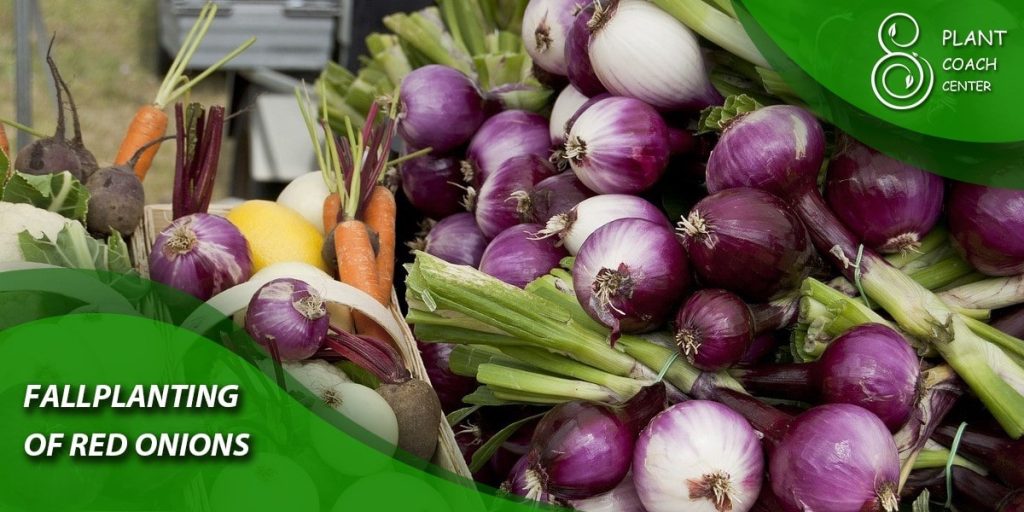
Fall Planting of Red Onions
Fall planting of red onions offers several advantages, including an extended growing season and early harvest in the following year. Follow these steps for successful fall planting:
Advantages of Fall Planting
Fall planting provides unique benefits for red onion cultivation:
– Extended Growing Season: By planting in the fall, red onions have a head start and establish their root systems before winter arrives. This results in earlier growth and a longer growing season the following year.
– Bolting Prevention: Red onions are prone to bolting, which is the premature formation of flower stalks. Fall planting reduces the risk of bolting as the onions experience colder temperatures during their vegetative growth period.
– Availability of Garden Space: Fall planting allows you to utilize garden space that would otherwise remain unproductive during the winter months. Red onions can be planted alongside other cold-tolerant vegetables or cover crops.
Preparing for Fall Planting
Proper preparation is essential for successful fall planting of red onions:
– Clearing and Amending the Soil: Clear the garden bed of any existing crops or debris. Amend the soil with organic matter, such as compost or well-rotted manure, to improve fertility and structure.
– Choosing Onion Sets or Seedlings: Select healthy red onion sets or seedlings for fall planting. Look for firm bulbs and disease-free foliage.
– Calculating Planting Time: Determine the ideal planting time based on the days to maturity for your selected red onion variety. Count backward from the first expected frost date in your area, allowing enough time for the bulbs to mature before winter.
Planting Red Onion Sets or Transplants in Fall
Planting red onion sets or transplants in the fall is a straightforward process. Follow these steps:
Preparing the Bed: Ensure the soil is well-prepared and free of weeds. Create small furrows spaced 12-18 inches (30-45 cm) apart, suitable for planting the sets or seedlings.
Planting Depth and Spacing: Place each onion set or transplant in the furrow, burying the bulb partially with the top exposed. Maintain a spacing of 4-6 inches (10-15 cm) between the sets or seedlings.
Covering and Watering: Gently cover the sets or seedlings with soil, firming it around the bulbs. Water the bed thoroughly to settle the soil and provide initial moisture for the plants.
Mulching and Protection: Apply a layer of mulch, such as straw or shredded leaves, to insulate the soil and regulate temperature fluctuations. This helps protect the young plants from extreme cold and frost.
Watering and Maintenance: Water the bed regularly, ensuring the soil remains consistently moist. Monitor for pests, diseases, and weeds, and take appropriate actions to address them.
Fertilization: Apply a balanced fertilizer or organic amendments as needed during the fall. Red onions can benefit from a slow-release fertilizer or a top dressing of compost.
Overwintering: As winter approaches, the red onions will enter a dormant phase. Minimal maintenance is required during this time. Ensure the soil remains moist but not waterlogged.
Spring Care: As temperatures rise in spring, the red onions will resume active growth. Resume regular watering, fertilization, and pest control measures as needed.
Harvesting: Harvest the red onions when they reach maturity, typically in late spring or early summer. The bulbs should have developed their characteristic red skin and firm texture. Lift the bulbs carefully using a garden fork, and allow them to dry and cure before storage.
Fall planting of red onions requires careful planning and attention to timing. By following these steps, you can enjoy an early and bountiful harvest of red onions the following year.
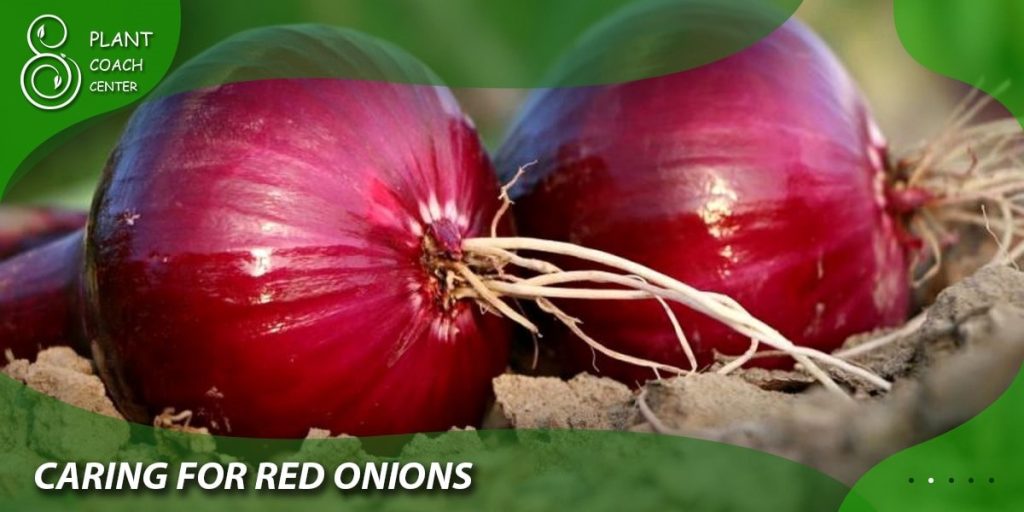
Caring for Red Onions
To ensure healthy growth and maximum yields, red onions require proper care throughout their growth cycle. Consider the following care guidelines:
Watering
– Consistent Moisture: Red onions require consistent soil moisture to thrive. Aim for an inch (2.5 cm) of water per week, either through rainfall or irrigation.
– Watering Frequency: Water deeply but infrequently to encourage deep root growth. Avoid overwatering, as it can lead to diseases and bulb rot. Allow the soil to dry slightly between watering sessions.
Mulching and Weed Control
– Mulching Benefits: Apply a layer of organic mulch around red onion plants to conserve moisture, suppress weed growth, and maintain a more stable soil temperature.
– Weed Management: Regularly inspect the bed for weeds and remove them promptly to prevent competition for nutrients and water. Be cautious when weeding to avoid damaging the shallow onion roots.
Fertilization
– Balanced Fertilizer: Red onions benefit from a balanced fertilizer application during their growth period. Use a fertilizer with equal or slightly higher phosphorus and potassium levels compared to nitrogen.
– Fertilizer Application: Apply the fertilizer according to the package instructions, usually in early spring when the plants are actively growing. Avoid over-fertilization, as it can lead to excessive leaf growth and reduced bulb development.
Pest and Disease Control
– Pest Monitoring: Regularly inspect red onion plants for common pests such as onion thrips, onion maggots, and aphids. Use organic pest control methods or insecticidal soaps if necessary.
– Disease Prevention: Practice crop rotation to minimize the risk of soil-borne diseases. Avoid planting onions in areas that recently grew other allium crops. Proper spacing and good air circulation can help prevent foliar diseases like onion rust and downy mildew.
Harvesting and Storage
– Maturity Signs: Red onions are typically ready for harvest when the tops begin to dry and flop over. The bulbs should have reached their desired size and developed a firm texture.
– Harvesting Technique: Gently lift the red onions from the soil using a garden fork or trowel. Avoid damaging the bulbs or bruising them during harvest.
– Curing and Storage: After harvest, allow the onions to dry and cure in a well-ventilated, dry area for a few weeks. Remove any remaining foliage once the bulbs are fully cured. Store the onions in a cool, dry, and dark location with good air circulation.
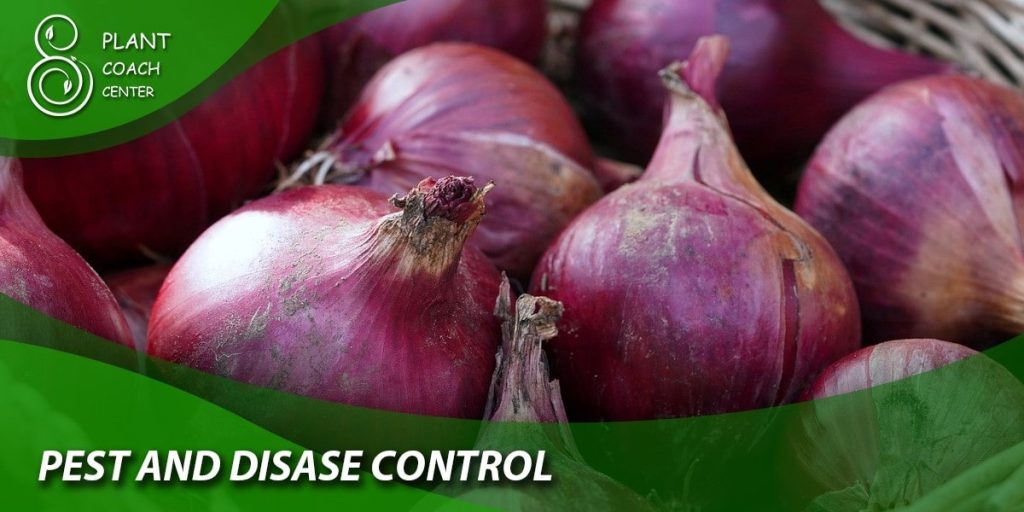
Conclusion
fall planting of red onions offers numerous benefits, including an extended growing season, early harvest the following year, and efficient use of garden space. By following the steps outlined for fall planting and providing proper care throughout the growing cycle, you can ensure healthy onion plants and maximize your yields.
Key points to keep in mind for successful red onion cultivation include:
Preparing the soil: Clear the garden bed of debris, amend the soil with organic matter, and ensure it is well-drained.
Choosing onion sets or seedlings: Select healthy red onion sets or seedlings with firm bulbs and disease-free foliage.
Planting in the fall: Plant the onion sets or transplants in furrows, burying the bulbs partially with the tops exposed, and space them 4-6 inches apart.
Mulching and protection: Apply a layer of mulch to insulate the soil and protect the young plants from extreme cold and frost.
Watering and maintenance: Provide consistent moisture, water deeply but infrequently, and promptly remove weeds.
Fertilization: Apply a balanced fertilizer during the growth period, following package instructions to avoid over-fertilization.
Pest and disease control: Monitor for pests and diseases, practice crop rotation, and take appropriate measures to address issues.
Harvesting and storage: Harvest the red onions when the tops dry and flop over, cure them in a well-ventilated area, and store them in a cool, dry, and dark place.
By following these guidelines and adjusting them to your specific growing conditions, you can enjoy a successful red onion harvest with flavorful and vibrant bulbs. With proper care and attention, your red onions will thrive and provide a delicious addition to your culinary creations. Happy gardening!







